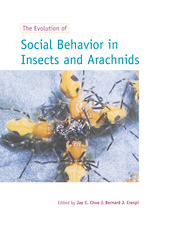Book contents
- Frontmatter
- Contents
- Contributors
- Acknowledgements
- Introduction
- 1 Are behavioral classifications blinders to studying natural variation?
- 2 Life beneath silk walls: a review of the primitively social Embiidina
- 3 Postovulation parental investment and parental care in cockroaches
- 4 The spectrum of eusociality in termites
- 5 Maternal care in the Hemiptera: ancestry, alternatives, and current adaptive value
- 6 Evolution of paternal care in the giant water bugs (Heteroptera: Belostomatidae)
- 7 The evolution of sociality in aphids: a clone's-eye view
- 8 Ecology and evolution of social behavior among Australian gall thrips and their allies
- 9 Interactions among males, females and offspring in bark and ambrosia beetles: the significance of living in tunnels for the evolution of social behavior
- 10 Biparental care and social evolution in burying beetles: lessons from the larder
- 11 Subsocial behavior in Scarabaeinae beetles
- 12 The evolution of social behavior in Passalidae (Coleoptera)
- 13 The evolution of social behavior in the augochlorine sweat bees (Hymenoptera: Halictidae) based on a phylogenetic analysis of the genera
- 14 Demography and sociality in halictine bees (Hymenoptera: Halictidae)
- 15 Behavioral environments of sweat bees (Halictinae) in relation to variability in social organization
- 16 Intrinsic and extrinsic factors associated with social evolution in allodapine bees
- 17 Cooperative breeding in wasps and vertebrates: the role of ecological constraints
- 18 Morphologically ‘primitive’ ants: comparative review of social characters, and the importance of queen–worker dimorphism
- 19 Social conflict and cooperation among founding queens in ants (Hymenoptera: Formicidae)
- 20 Social evolution in the Lepidoptera: ecological context and communication in larval societies
- 21 Sociality and kin selection in Acari
- 22 Colonial web-building spiders: balancing the costs and benefits of group-living
- 23 Causes and consequences of cooperation and permanent-sociality in spiders
- 24 Explanation and evolution of social systems
- Organism index
- Subject index
21 - Sociality and kin selection in Acari
Published online by Cambridge University Press: 06 July 2010
- Frontmatter
- Contents
- Contributors
- Acknowledgements
- Introduction
- 1 Are behavioral classifications blinders to studying natural variation?
- 2 Life beneath silk walls: a review of the primitively social Embiidina
- 3 Postovulation parental investment and parental care in cockroaches
- 4 The spectrum of eusociality in termites
- 5 Maternal care in the Hemiptera: ancestry, alternatives, and current adaptive value
- 6 Evolution of paternal care in the giant water bugs (Heteroptera: Belostomatidae)
- 7 The evolution of sociality in aphids: a clone's-eye view
- 8 Ecology and evolution of social behavior among Australian gall thrips and their allies
- 9 Interactions among males, females and offspring in bark and ambrosia beetles: the significance of living in tunnels for the evolution of social behavior
- 10 Biparental care and social evolution in burying beetles: lessons from the larder
- 11 Subsocial behavior in Scarabaeinae beetles
- 12 The evolution of social behavior in Passalidae (Coleoptera)
- 13 The evolution of social behavior in the augochlorine sweat bees (Hymenoptera: Halictidae) based on a phylogenetic analysis of the genera
- 14 Demography and sociality in halictine bees (Hymenoptera: Halictidae)
- 15 Behavioral environments of sweat bees (Halictinae) in relation to variability in social organization
- 16 Intrinsic and extrinsic factors associated with social evolution in allodapine bees
- 17 Cooperative breeding in wasps and vertebrates: the role of ecological constraints
- 18 Morphologically ‘primitive’ ants: comparative review of social characters, and the importance of queen–worker dimorphism
- 19 Social conflict and cooperation among founding queens in ants (Hymenoptera: Formicidae)
- 20 Social evolution in the Lepidoptera: ecological context and communication in larval societies
- 21 Sociality and kin selection in Acari
- 22 Colonial web-building spiders: balancing the costs and benefits of group-living
- 23 Causes and consequences of cooperation and permanent-sociality in spiders
- 24 Explanation and evolution of social systems
- Organism index
- Subject index
Summary
ABSTRACT
Social organization in the subclass Acari involves parental care and various forms of communal behavior. I first describe subsocial behavior in two spider mite species and then discuss three examples of complex subsociality in Prostigmata and two in Mesostigmata. Aggregation within a narrow space is a common trait observed in all subsocial species. The deposition of feces at certain places (or other nest sanitation behavior) is also common to these species. Subsociality in the Acari is always associated with malehaploid or thelytokous genetic systems, and kin selection under male–haploid genetic system may be important in the evolution of sociality. I next discuss why there is no evidence of eusociality in the Acari, although highly developed subsociality is observed and high relatedness of individuals is expected. One of the plausible explanations is that their simple neural systems decrease the probability of kin recognition; another possibility is that continuous inbreeding decreases the likelihood of the origin of eusociality.
INTRODUCTION
Mites and ticks (Acari) are small organisms with low mobility, and such low mobility may increase the likelihood of interaction among kin. If kin selection (Hamilton 1964a,b) is an important prime mover of social evolution in animals, then we might expect to find examples of sociality in the Acari. However, evidence of social behavior in this group has been scarce; for example, Buskirk (1981) included only 40 lines describing mite behavior in a review of arachnid sociality.
Information
- Type
- Chapter
- Information
- The Evolution of Social Behaviour in Insects and Arachnids , pp. 443 - 457Publisher: Cambridge University PressPrint publication year: 1997
Accessibility standard: Unknown
Why this information is here
This section outlines the accessibility features of this content - including support for screen readers, full keyboard navigation and high-contrast display options. This may not be relevant for you.Accessibility Information
- 37
- Cited by
